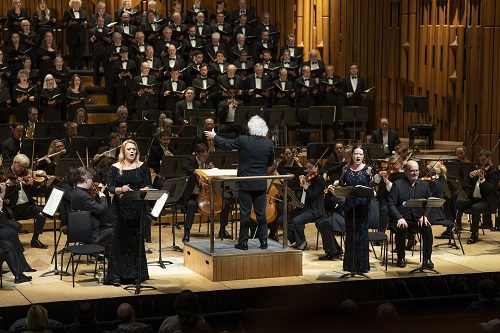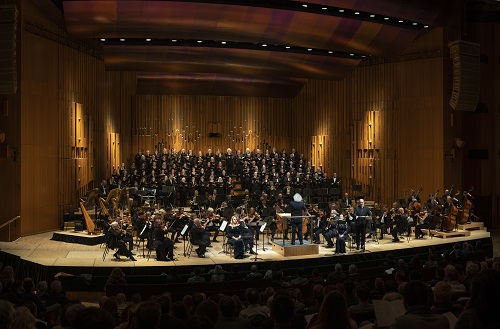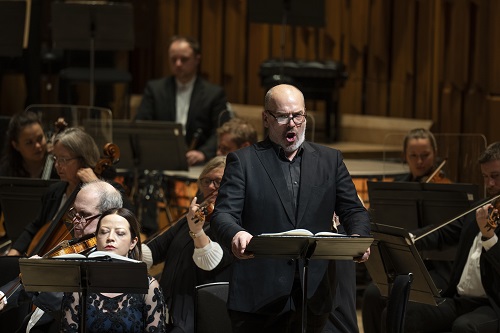There seems to be much sorrow in the world at the moment, but little serenity. This concert by the London Symphony Orchestra thus offered a welcome balancing of affekts, the intimate intensity of Karol Szymanowski’s Stabat Mater preceding the gentle warmth and sureties of Johannes Brahms German Requiem.
In 1924, when Szymanowski was commissioned by Princess Edmond de Polignac to write a choral work he initially envisaged a sort of ‘Peasants’ Requiem’, but following the deaths of the composer’s niece, Alusia Bartoszewicz, these early ideas developed into the six-movement Stabat Mater, the text of which is a Polish translation of the familiar medieval Latin text. It’s a work Sir Simon Rattle knows intimately – his 1994 EMI recording with the City of Birmingham Orchestra and Chorus was and remains highly acclaimed – and at the Barbican Hall his attention to detail brought forth both the mysticism of the East and the medievalism of the past. The clarity and sparseness of the textures at times seemed neoclassical, but there were also moments of vigour and richness: indeed, the musical contrasts gave life to the musical imagery and brought forth the passion of the text. This is a sombre work, yet it shimmers. Here, the lament struck the heart, but was never sentimental.

In the first movement, ‘At the Cross her station keeping’, the contrast of cool woodwind and glowing strings and harp created an iridescent glow, over which the well-drilled LSO chorus enunciated their Polish consonants with plosive crispness. There was a pleading tone, and the string vibrato was finely graded, saved for moments of intensity. ‘Is there one who would not weep’ pushed forwards persuasively, Florian Boesch singing with colour and energy, at times with a fierce power infusing the eloquence, the movement driven on by strong choral punctuations. Clarinet and bassoon brought plangency to ‘Can the human heart refrain’, in which the expressive low hues of mezzo-soprano Hanna Hipp were complemented by the operatic radiance of soprano Iwona Sobotka whose repetitions, “Matko, matko” (Make me feel as thou has felt; make my soul to glow and melt with the love of Christ my Lord) had a quasi-sensuous intensity. How wonderful to have two Polish singers communicating this text, and when they sang in unison, “Rodzonego, męczonego” (Holy Mother! Pierce me through in my heart) they reached out powerfully.
The a capella fourth movement, ‘Let me share with thee his pain’, had a hymn-like composure but the climactic fifth movement, ‘Let me, to my latest breath’, was energised from the deep – the double basses’ forthright movement initiating a growing orchestral weight which Boesch was more than equal to. The bass-baritone’s lines may not always have been etched with refinement, but there was grandeur here and powerful committed interpretation. The LSO Chorus, complemented by bright percussive flickers, pushed towards the radiant blaze of the conclusion – a vision of Judgement Day. In the final movement, ‘Christ, when thou shalt call me hence’, the three soloists turned to face the Chorus as the latter intoned with grave quietude: “When my body dies,/ let my soul be granted/ the glory of Paradise.”
In his Ein Deutsches Requiem, the agnostic, humanist Brahms was more concerned with consoling the living than the dead. Yet, he too rooted his lament – probably inspired by the death of his mother in February 1865 but originating in much earlier ideas generated by his first meeting, as a 20-year-old, with Robert and Clara Schumann in the 1850s – in his homeland, his mass for the dead not part of the Catholic liturgy but a personal testament (‘a’ requiem, not ‘the’ Requiem), delivered in his native German.

There is a quiet joy – ‘serenity’ is indeed an apt word – in the Deutsches Requiem that is found, too, in a letter Brahms that wrote to Clara Schumann in March 1865, in which he discussed the progress of his composition of the Requiem: ‘The world is round and it must turn; what God does is well done; consider the lilies, etc.: or better still, don’t think at all, for things cannot be altered, and a wise man repents of nothing.’ Such assurance is probably most pointedly expressed in the Requiem in the concluding fugue of the third movement, ‘Herr, lehre doch mich’ (Lord, make me to know mind end’, which surges above a sustained pedal point and is complemented by bright trumpets, both expressive of the certainties of the text: “The souls of the righteousness are in the hands of God and no torment shall touch them.”
It was a bold musical move by Brahms though to chain the fugue harmonically in this way, and it met with a hostile critical reception at the first performance. But, at the Barbican Hall, Rattle managed to sustain the sense of the world’s inexorable ‘turning’. Throughout the Requiem, gentleness was balanced with persuasive forward movement – the performance came in at more or less an hour.
Perhaps it helped that Rattle retained the small orchestral forces required in the Szymanowski, even though the LSO Chorus was more than 100-strong. But, it was evident from the first movement, ‘Selig sind, die da leid tragen’ (Blessed are they that mourn), that a consistent, inexorable pulse would be complemented by subtle ebbs and flows, and that clarity would prevail even in Brahms’ more grandiloquent gestures. The precision of the LSO Chorus in the opening movement contributed to the reverential air, and Rattle built to a sense of wonder, rhythms gaining ardency – his coaxing was understated but achieved its potent intent.

The triplet-triggered rhythmic tread that propels the second movement, ‘Denn alles leisch es ist wie Gras’ (For all flesh is grass), was grave but purposeful; the element of theatricality was, appositely, not fully tempered, and the entry of the Chorus initiated a lovely fluidity through the comforting major-key episode; the counterpoint of the men’s voices at the close was uplifting. In the afore-mentioned ‘Lord, make me to know mind end’, there was a sustained sense of growing, responding. Florian Boesch’s pronouncements were magisterial and invigored, though I found them a bit effortful at times – a little less would have been more commanding.
Rattle shaped the fugues which close the fourth and sixth movement with real skill and clarity, confirming the affirmative tone he had wrought. In the fifth movement, ‘Ihr habt nun Traurigkeit’ (And ye now therefore have sorrow), the power and resonance of Sobotka’s soprano seemed a little out of place; there was little of the required ‘innocence’ here, though there was beauty of tone and sensitive phrasing, and the vocal lines were sensitively complemented by the woodwind. The final movement, ‘Blessed are the dead’ confirmed the Chorus’s stamina – though the sopranos fared better than the tenors at the top.
The silence which followed the close was moving. Again, ‘reverence’ is the word that comes to mind. This was a performance of Ein Deutsches Requiem which was, as Brahms would surely have wished, intended to speak not to those departed to the afterlife, but to those in the Barbican Hall and elsewhere in the world, and which aimed to bring serenity to their sorrow.
Claire Seymour
Sorrow and Serenity: Karol Szymanowski – Stabat Mater, Johannes Brahms – German Requiem
Iwona Sobotka (soprano), Hanna Hipp (mezzo-soprano), Florian Boesch (bass-baritone), London Symphony Orchestra, Sir Simon Rattle (conductor), London Symphony Chorus, (Simon Halsey, chorus director)
Barbican Hall, London; Saturday 17th December 2022.
ABOVE: Iwona Sobotka (c) Andy Paradise